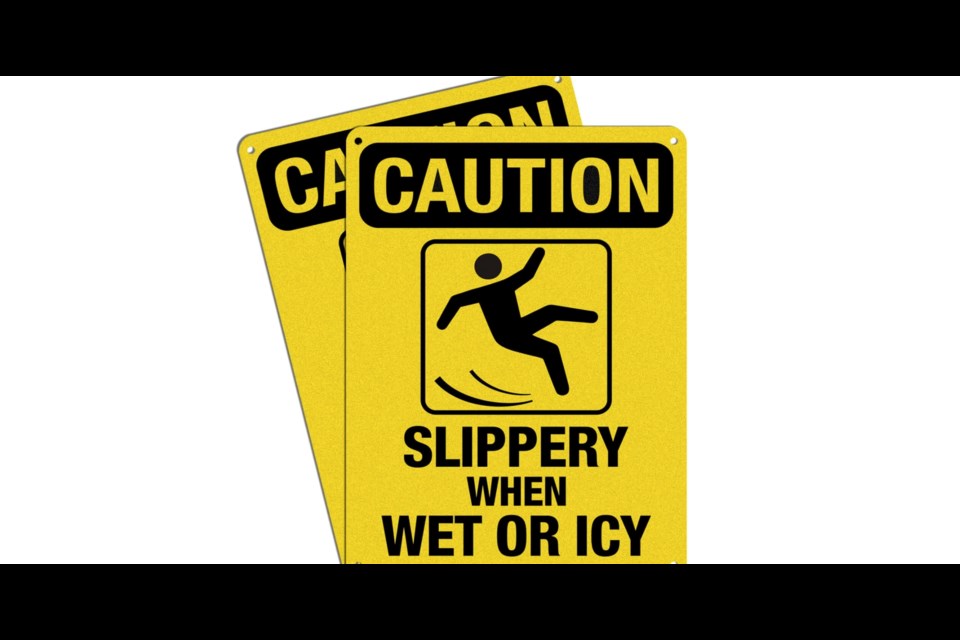As freeze, thaw and freeze temperatures continue across the Lakeland, Ice safety isn’t only an issue for area lakes; local sidewalks, paths, driveways — and almost any flat outdoor surface — also need extra attention as these kinds of weather trends continue.
In Lac La Biche County, there are bylaws in place mandating that residential sidewalks are cleared by property owners within 72 hours of a snowfall, and municipal crews are dispatched as quickly as possible for public properties. But when weather conditions change several times within that timeframe — as they have over the last several weeks — residents are urged to take extra caution.
Lac La Biche County’s Communications Manager Jihad Moghrabi says the bylaws are meant to reduce the amount of snow that can cover hidden hazards, including ice that forms as the snow is packed down. This makes sidewalks even trickier to navigate, especially for residents with mobility issues.
“Of course, we also recommend that residents take their time and pay special attention to sidewalk, roadway, and driveway conditions in the wintertime, especially as the seasons shift or warm and cold weather conditions cycle and shift quickly,” Moghrabi told Lakeland This Week.
Along with shovels, snowblowers and sensibility, Moghrabi says sand is another ally in the local ice-fight.
Lac La Biche County delivered a handout to businesses along Main Street in October of 2023 identifying the advantages of using sand over salt to keep ice at bay on the new, $34 million downtown streetscape. Moghrabi said while some believe sand and salt are used for the same purpose – to melt ice – sand, he explained, is used to improve traction.
“Sand crystals increase friction and help prevent vehicles and pedestrians from slipping,” Moghrabi stated. “And, as the handout notes, salt is corrosive, and can accelerate the deterioration of sidewalks, while sand does not cause damage. Using sand will keep our new Main Street looking pristine for longer.”
For those walking on the local sidewalks, common sense is the best way to avoid slip-and fall situations, says Mona Frederick, the executive director of the Lac La Biche Heritage Society.
“It would seem that our seniors have good common sense and try not to wander about when there are icy conditions,” she said, adding that many seniors who she knows, wear slip-on ice grips on their shoes or boots, or good-traction footwear when out and about in these conditions.
For those walking off the beaten paths — or where there are no paths at all — the ice dangers are not just about how slick the ice is, but also how thick the ice is.
The unpredictability of Mother Nature in recent weeks is matched by the unpredictability of ice surfaces covering water bodies, says Lac La Biche County Deputy Fire Chief Chris Newhook.
He says ice thickness is never consistent, adding that many factors contribute to thickness and quality of ice, including fluctuating temperatures.
He too says common sense is the best defence when dealing with a trip onto the ice.
“There is no such thing as 100 per cent safe ice…if you don’t know, don’t go,” he stated, explaining the caution applies to residents and their four-legged friends. “Keep your pets away from all bodies of water and ice. If necessary, keep your dog on a leash during fall and spring freeze-thaw cycles.”
Lac La Biche Protective Services Ice Thickness Recommendations:
15cm (about 5.91 in) for individual person walking, skating, fishing, skiing
20cm (about 7.87 in) for groups of people
25cm (about 9.84 in) for snowmobile or Off Highway Vehicle (OHV)
30+cm for car or light duty truck
Through the winter months, staff with the municipality maintain an ice road that stretches across the community’s namesake lake from the Lac La Biche Mission to Poplar Point, a distance across the ice of about five kilometres. Newhook said with the recent warm temperatures, the ice thickness along the well-travelled ice road is monitored frequently. Going into the weekend, the most recent test of the thickness found the ice surface to average 66 centimetres.
“During the cooler temperatures tests were being conducted approximately every two weeks,” he explained. “With the temperatures warming up, testing will be conducted more frequently.
Newhook said as seasons transition and the ice begins to degrade, people must be extra cautious with pets near waterways.
Newhook stated that if an animal for person falls into water or through ice, call 911 immediately and do not attempt to rescue them. At the same time, he continued, keep an eye on them while remaining on the phone with 911.



